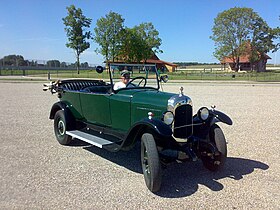Berliet was a French manufacturer of automobiles, buses, trucks and military vehicles among other vehicles based in Vénissieux, outside of Lyon, France. Founded in 1899, and apart from a five-year period from 1944 to 1949 when it was put into 'administration sequestre' it was in private ownership until 1967 when it then became part of Citroën, and subsequently acquired by Renault in 1974 and merged with Saviem into a new Renault Trucks company in 1978. The Berliet marque was phased out by 1980.

The Nissan Sunny is an automobile built by the Japanese automaker Nissan from 1966 till 2004. In the early 1980s, the brand changed from Datsun to Nissan in line with other models by the company. Although production of the Sunny in Japan ended in 2004, the name remains in use in China and GCC countries for a rebadged version of the Nissan Almera.

Alpina Burkard Bovensiepen GmbH & Co. KG is an automobile manufacturing company based in Buchloe, in the Ostallgäu district of Bavaria, Germany that develops and sells high-performance versions of BMW cars. Alpina works closely with BMW and their processes are integrated into BMW's production lines, and is recognized by the German Ministry of Transport as an automobile manufacturer, in contrast to other performance specialists, which are aftermarket tuners. The Alpina B7 is produced at the same assembly line in Dingolfing, Germany, as BMW's own 7 Series. The B7's twin-turbo 4.4-litre V8 is assembled by hand at Alpina's facility in Buchloe, Germany, before being shipped to BMW for installation, and the assembled vehicle is then sent back to Alpina for finishing touches.

The Citroën Type A was produced from June 1919 to December 1921 in Paris, France. It was the first car Citroën made. 24,093 were built.

The Fiat 518, also called Fiat Ardita, was a model of car produced by Italian car manufacturer Fiat between 1933 and 1938. The name "Ardita" was also used on the six-cylinder engined and more expensive Fiat Ardita 2500 or 527.

The Citroën Type C was a light car made by the French Citroën car company between 1922 and 1926 with almost 81,000 units being made. Known as Citroën 5HP or 5CV in France and 7.5HP in Britain, it was the second model of automobile designed and marketed by André Citroën, between 1922 and 1926. It followed the 10HP "Type A " (1919), then 10HP "B2" (1921); they were the first European mass-produced cars.
Buchet was a French motorcycle and automobile manufacturer between 1899 and 1930.

The Peugeot 402 is a large family car produced by Peugeot in Sochaux, France, from 1935 to 1942. It was unveiled at the Paris Motor Show in 1935, replacing the Peugeot 401.
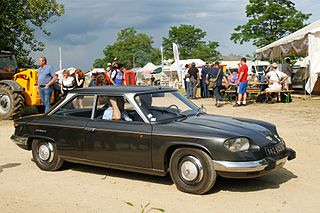
The Panhard 24 is a compact two-door coupé automobile produced between 1964 and 1967 by French manufacturer Panhard. It was powered by a front-mounted air-cooled two-cylinder boxer motor: the basic design of this unconventional engine dated back to the 1940s. In 1965, a lengthened Panhard 24 was launched and promoted as a two-door four- or five-seat saloon. Plans for a four-door version which might have enabled the car more effectively to replace the commercially successful Panhard PL 17 saloon were never implemented, however.

Charron was a French automobile manufacturer, based in the Paris conurbation, and active between 1906 and 1930.

The Benz 10/25 PS was a midsize automobile introduced by Benz & Cie in 1912. The same year stated maximum output was increased which meant a name change to Benz 10/30 PS. The model disappeared for three years following the First World War but returned in 1921. A further power increase in 1926 meant another name change, now to Benz 10/35 PS. Following the "fusion" between the Daimler and Benz companies, production of the Benz 10/35 PS ended in 1927.

The Berliet Dauphine is a family car produced by Berliet at their Vénissieux plant on the south side of Lyon between summer 1934 and 1939. The original cars had a 1990cc engine placing them in the 11CV car tax band, but this was quickly joined by a 1,600cc (9CV) version, and at one stage a 14CV powered version was advertised as available “sur commande”.

SA des Anciens Établissements Secqueville-Hoyau was a French automobile producer between 1919 and 1924. The factory was established in what was then a small town, a short distance to the north-west of Paris, called Gennevilliers.
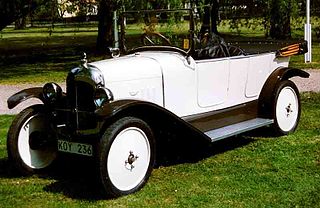
The Citroën B2 is the second model produced by Citroën. It is therefore the second European car to have been constructed according to modern mass production technologies. It was produced at André Citroën's factory in central Paris between May 1921 and July 1926.

The Citroën B10 is an automobile produced by Citroën at André Citroën's factory in central Paris between 1924 and 1925.

The Nervastella is a large automobile constructed by Renault between 1930 and 1937. It was used as a state car and pictures of the president of the French Republic sitting in a Nervastella can therefore be seen in newsreels from the mid-1930s.
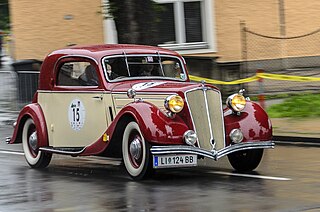
The Salmson S4 is a mid-size executive-level car introduced as the Salmson S4 C by Société des Moteurs Salmson in Autumn 1932. It was the manufacturer's principal and often sole model for the next twenty years.
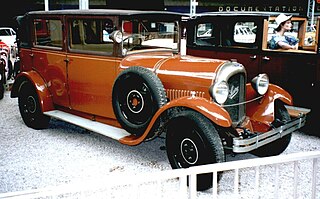
Automobiles J. Suère was a French manufacturer of automobiles between 1909 and 1931.

The Vivaquatre is a car produced by Renault between 1932 and 1939. Its large 4-cylinder engine placed it initially in the 10CV car tax class, though a larger engine later made it a contender in the 11CV class.

The Renault Vivasport was a 6-cylinder engined executive automobile introduced by Renault in September 1933 and produced till April 1935. A larger engined version was produced between December 1934 and February 1938. As with many Renaults during the 1930s, type changes as well as small often cosmetic facelifts and upgrades appeared frequently.
